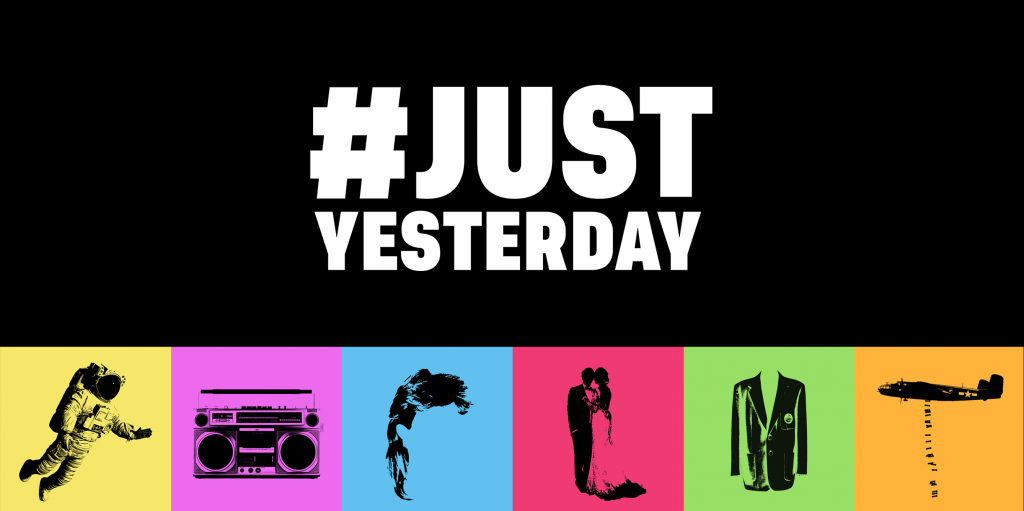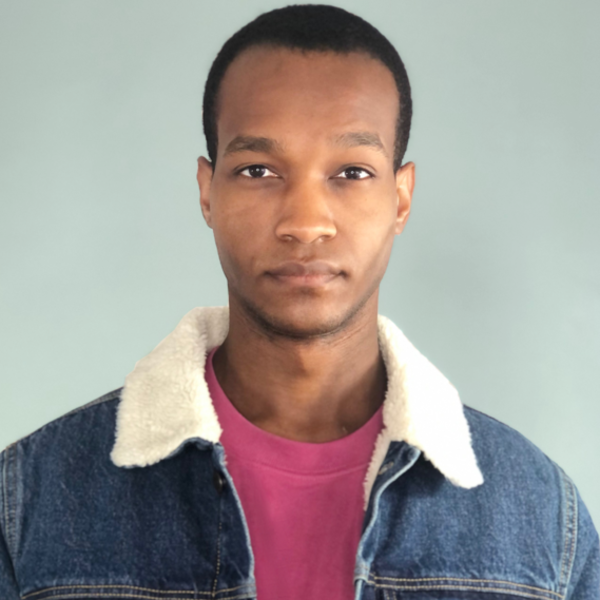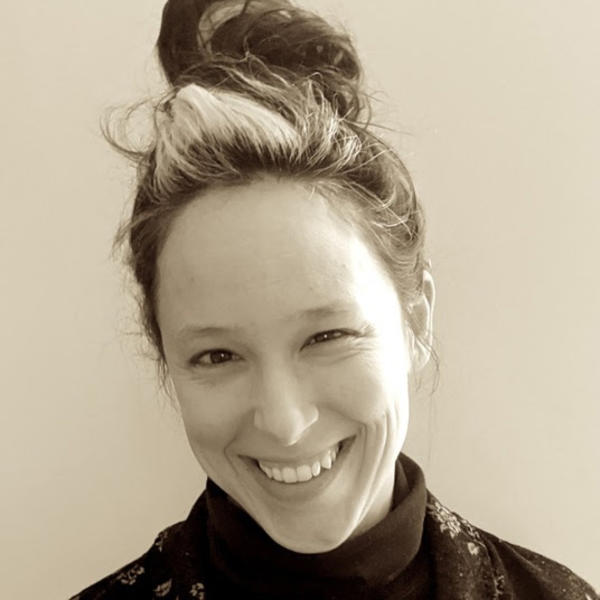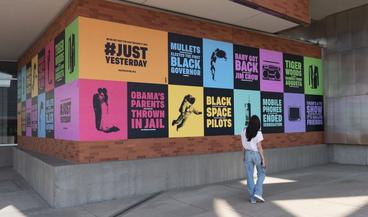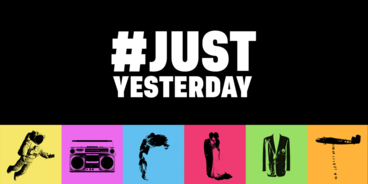This summer, the Weisman's exterior façade features a series of poster designs, collectively entitled Just Yesterday, which will be on view through October 1, 2021. Just Yesterday was conceived by interning art director Mike Gaines and first-year copywriter Maggie Williams, as part of an initiative by Minneapolis advertising agency Solve, during the protests that swept the world in 2020. The series uses iconic pop culture references to put systemic injustices from our recent past into context — injustices that continue to oppress communities of color to this day. Earlier this spring, the students of WAM Collective interviewed the series creators, digging deeper into the inspiration and aspirations of the project.
What prompted you to create this series of posters, and to create them now?
Maggie Williams: When we conceived of the series, we were freshly in the wake of George Floyd’s murder. Solve briefed the entire creative team, with a wide-open question: How could we help people understand the current state of racism in this country? We explored a lot of ideas about what form that could take: video, textbook, audio experience. In the end, a simple, headline-driven campaign felt like it would be the simplest way to engage people.
Mike Gaines: Racial inequality was dominating the discourse across the country after George Floyd was murdered. As we thought of ways we could contribute to the conversation, we wanted the poster series' straightforward messages to bring to light just how recent and current this state of injustice is.
What is your working relationship with each other? Have you worked together prior to this project?
Mike Gaines: Maggie and I had never worked together previously. In fact, we'd just met remotely within my first week interning at Solve. It was exciting to take on such a great social and creative challenge as part of a new partnership, particularly with Maggie, who already had industry experience. We conducted a few brainstorming sessions through a shared document and developed the campaigns through a series of Zoom calls.
Maggie Williams: Mike had just started at Solve as an intern, and I had been there as a copywriter for only three months. So, we were both brand new. This was the first and only thing we worked together on. It was definitely a vulnerable, intimate project to collaborate on (remotely!) with someone I’d just met.
Did you approach this serious subject matter differently than other projects you’ve worked on?
Maggie Williams: For me (and I say this from the lens of a white woman, for whatever that’s worth), I did have to approach this differently. For any brand campaign, the “who is this coming from?” is usually already decided. For most projects: it’s coming from the brand. And because it’s an established brand, I know what the voice is. I know what is and isn’t appropriate territory. But because this was coming from us—just a group of human beings who work together, in a predominantly white workplace—I had to think a lot about finding a genuine way to talk to people.
Mike Gaines: The serious issue of racial injustice was far different from any other campaign I had worked on, in college or previous intern experiences. Despite the difference in tone and call to action, however, the process of developing the campaign was somewhat similar. We started with ideation, identifying our target audiences, and executing against different insights. Although the end goal is not to make people purchase a product, we did want to create work that persuades viewers to think critically and take action.
In regards to the visual style of these posters, where did you draw inspiration? How did you decide to pair the serious topics with their almost playful appearance?
Mike Gaines: The posters' headlines and subject matter are both very serious. However, we noticed when people come across content that they can tell is going to be heavy, they tend to disengage. The playfulness of the visuals adds tension to the campaign, roping unsuspecting viewers into engaging with harder-hitting subject matter.
Maggie Williams: The whole thing is meant to evoke the feeling of nostalgia, like a BuzzFeed quiz. It's the print version of clickbait. It draws you in, and then the real message catches you unaware. Unfortunately, if there’s a serious tone set for something right away, it can be easy to tune it out if you’re not in the mood. These is meant to be a gut punch you aren’t expecting.
The posters all have ties to pop culture. Why did you choose the references you did, like Friends, Tiger Woods, and “Baby Got Back”?
Mike Gaines: The discourse around racial injustice and the struggle for civil rights is often positioned to be a thing of the distant past, in both conversation and traditional educational curricula. The pop culture references all point to events or people who were prominent somewhat recently, and still feel top of mind universally. As viewers read the posters and capture the full message, it is revealed that systemic racial injustices are just as recent. The cultural touchpoints in the posters also cast a wide net, with a variety of references likely to be significant to many age groups, in one way or another.
Maggie Williams: I was born in '89, right in the middle of the Millennial range. These are cultural touchstones from the ‘90s that a lot of people my age will relate to, but they’ve been around long enough to have kind of come back to life and have a currency with Gen Z, as well. These pop culture references have a catch-all effect, so that any person under the age of 40-ish (our intended audience) would think of them as fairly new.
When you were creating the posters, where did you envision them being hung?
Maggie Williams: Certainly, for me, it wasn't in an art museum. We thought about all the boards that went up onto buildings during the uprisings in Minneapolis—buildings that weren’t even being occupied due to COVID—and considered wheat-pasting them there. For the most part, we just thought: Let’s get them up. Let’s not seek permission. Let’s just put them where people will see them.
Mike Gaines: Honestly, while creating the posters, I was just excited at the mere thought of being able to get this out into the world in one way or another. We thought that they might ultimately live on social media, in the Solve office windows, or wheat-pasted wild postings. Just getting the posters seen was an achievement in itself. But at no point did I envision these being on display at an art museum.
Do you think that having them installed here in Minneapolis— given the uprising last summer, the killing of George Floyd, and the recent murder of Daunte Wright—adds to the potency of the posters’ message?
Mike Gaines: The title ,“Just Yesterday,” aims to illuminate the recency of racial injustices that are often attributed to the more distant past. It is unfortunate that inequality is evergreen content, such that it takes wrongful killing of people like George Floyd and Daunte Wright to start a wider conversation. All you can do is hope that people start making connections and change their attitudes and behaviors.
Maggie Williams: The “Just Yesterday” in the posters is talking about the civil rights movement of the 1960s, but it’s not a coincidence that the phrase still applies now. The struggle has never ceased. There is always something new to reference that happened “just yesterday.” I hope people will connect those dots.
It's been a hard year. What does self-care look like for you?
Maggie Williams: I’ve had a strict routine for the past 13 months that includes a lot of running, cooking, and hanging out with my wife. I embrace the dailiness of those routines; it has become almost meditative. I am fully vaccinated as of last week, so I’m only just starting to explore again what public, communal forms of self-care can look like. I used to go to this thing called "Dance Church" in South Minneapolis, and just move my body to club music in a daytime setting. I hope I get to do that again soon.
Mike Gaines: For me, staying occupied is a form of self-care. Like Maggie, my routine consists of staying active and spending time with my family. I’ve been very fortunate to have a nephew, graduate college, and be employed throughout quarantine. While the circumstances of the world is less than ideal, the internet has enabled me to collaborate with talented creatives, take on several passion projects, and stay in touch with my friends.
How do you sustain activism in your life without getting burnt out?
Mike Gaines: Last summer, consuming media became extremely fatiguing. Although it was a conversation that deserved to be had, checking my phone or TV to see bodycam videos, bystander footage, and commentary think pieces about Black people being murdered is exhausting. I think it's important to keep social justice as a part of discourse, but choosing to not engage in conversation with closed-minded individuals has helped. I have also focused my energy on taking part in activism that leads to actual outcomes, rather than just performance.
Maggie Williams: For me, a big part of that was eliminating things that were decidedly not helping. I deleted Facebook and Instagram last summer, because I spent so much time scrolling and letting myself get so distraught by willful ignorance about racial justice (and COVID, for that matter). I knew engaging them wouldn’t get me anywhere. So, I just got off social media and found different ways to connect with people I actually know, like friends and family. It was uncomfortable and stressful but, ultimately, a lot more fruitful.
What is the museum’s role in activism and anti-racism, as you see it? Do you feel museums have a responsibility to engage in these conversations?
Maggie Williams: I’ve been thinking a lot about that ever since I found out these posters were going into a museum. A museum’s role as a cultural curator is to champion the work of others, which of course includes deciding whose work is worth putting forth, and whose isn’t. We’ve got many walls in many famous museums that are covered entirely with paintings from white men. But it’s simply impossible that white men, such a small portion of the world’s population, have ever represented the majority of humanity's great artists. So it rests on museums, as—for better or worse—de facto arbiters of culture, to recognize great artists from groups that haven’t historically been represented, starting now and continuing forever. And while I don’t think we have to smash the entire canon, it’s necessary for art history as an academic discipline to include the work that should have been included all along. What else can possibly be said about Monet? Nothing. Dig deeper.
Mike Gaines: Museums serve as a gatekeeper of art and culture. As Maggie mentioned, oftentimes featured artwork comes from people of a similar, limited background–one that does not fairly represent the real world and all of its talented creators. I feel as if the issue of racism is far larger and more complex than can be fully addressed with wall space in a museum. It should not take a piece of art to make people realize that racism is a problem. However, representation is an important first step.
What do you hope people take away from this installation?
Maggie Williams: For a lot of white Americans, there’s a disconnect between the civil rights movement they read about in history books and the present-day racial justice movement. But when some aspects of state-sanctioned racism ended, the white supremacy those racist policies were designed to uphold didn’t just disappear. In some ways, since the Civil Rights Act, Voting Rights Act, and Fair Housing Act were passed, it’s gotten harder for our society to address racism head-on, because white people feel like those pieces of legislation put it to rest. If we can use pop culture touchstones to show people just how recent all of this institutional progress is, maybe they will realize the impossibility of believing we are already living in a post-racial society. What Mike and I are saying is: “It isn’t over. How can it be? This all happened just yesterday.”
